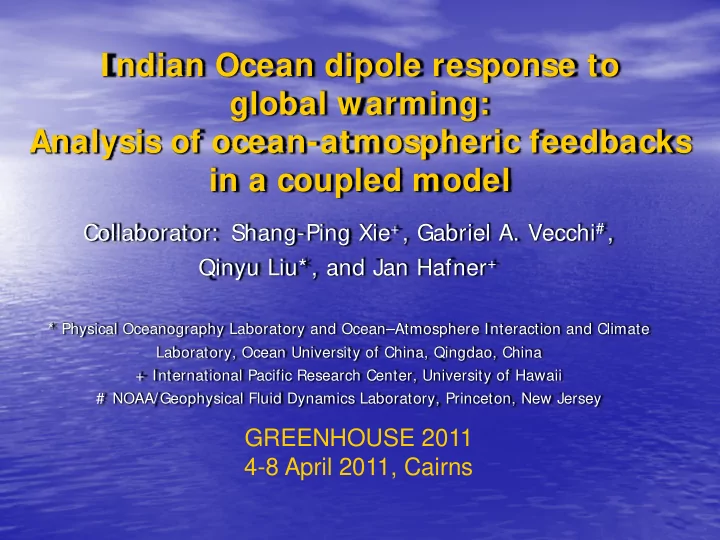

I ndian Ocean dipole response to global warming: Analysis of ocean-atmospheric feedbacks in a coupled model Collaborator: Shang-Ping Xie + , Gabriel A. Vecchi # , Qinyu Liu* , and Jan Hafner + * Physical Oceanography Laboratory and Ocean – Atmosphere Interaction and Climate Laboratory, Ocean University of China, Qingdao, China + International Pacific Research Center, University of Hawaii # NOAA/Geophysical Fluid Dynamics Laboratory, Princeton, New Jersey GREENHOUSE 2011 4-8 April 2011, Cairns
IOD and its intensification Indian Ocean Dipole (IOD) – SST and surface wind Saji et al., 1999 The IOD intensification in the 20 th Three consecutive positive IOD in 2006-2008 century. (Abram et al., 2008) The IOD recurrence in recent 150 years 2006 2007 2008
IOD intensification : A result of global warming? Sea level pressure Shoaling thermocline Indian Pacific Ocean Walker circulation is weakened Vecchi et al., 2006 in global warming Du and Xie, 2008 No intensification in coupled models 50-year running IOD variance in IPCC global warming simulations.
Our work: investigating the IOD response to global warming in GFDL CM2.1 spatial pattern phase locked Question: • Does IOD intensify in global warming following the thermocline shoaling? Why?
In constant GHG control run: Thermocline depth plays a key role on IOD intensity Shallow thermocline η σ (T) r= -0.57 IOD intensity VS thermocline depth Strong thermocline feedback R(T, η ) σ (T) r= 0.82 Strong IOD intensity IOD intensity VS thermocline feedback
Mean states change in global warming Weakened Walker circulation and dipole-like pattern The changes of SST (contour), rainfall (shading) and surface wind (vector) during global warming in boreal summertime.
EEIO: Thermocline shoaling, Unchanged SST variance Thermocline depth (Black line) Warming trend (color) along the equator Temperature variance (color) ? Unchanged IOD variance Thermocline feedback increasing
Weakened zonal wind feedback Relative Our hypothesis: constant rainfall (const) Weakened zonal wind variability Δ θ Atmospheric feedback is weakened. Troposphere warming
The evidence of the weakened zonal wind feedback The SVD results in different epochs support the weakened atmospheric feedback in global warming simulation. A simple LBM experiment is applied to test this hypothesis of the weakened feedback.
Weakened atmospheric feedback: In multi-model R(U,SST) R(U,Precip) R(Precip,SST) The weakened atmospheric feedback in the EEIO appears in most of the CMIP3 coupled models.
Other features of IOD change in global warming The IOD asymmetry weakens significantly under global warming. The ENSO-IOD correlation seems to decrease slightly in a warmer climate.
Summary • The thermocline feedback associated with the thermocline depth in the EEIO during the boreal summer is very important for the intensity of IOD in the interdecadal timescale. • In the global warming simulation, the thermocline in the EEIO is shoaling and thermocline feedback is enhanced. • Opposing oceanic feedback, atmospheric stability is increased and zonal wind feedback is weakened.
Summary • The variance of IOD does not change much. Our results suggest that the recent IOD intensification might be likely part of natural low-frequency modulation instead of global warming. • Other features change: Asymmetry weakens significantly. ENSO ‐ IOD relationship decreases slightly.
T h a n k y o u
Recommend
More recommend